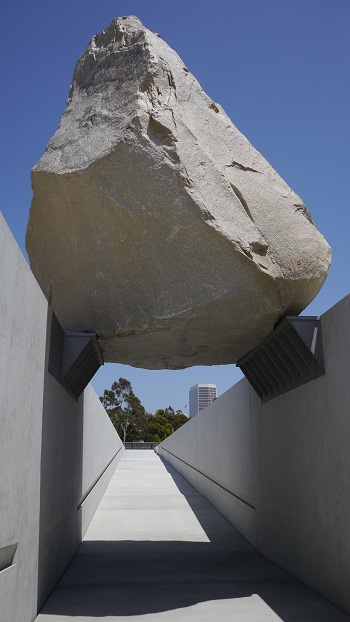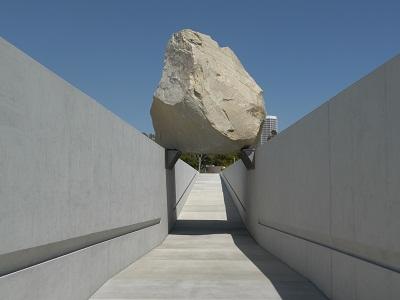“O ‘tis a passionate Work!—yet wise and well.” —William Wordsworth
In the glint of the gold morning light it can seem like an unpolished gem. Its fawn, fractured, and chipped surface is a kind of giant jewel captured for its powerful, compacted energy that exudes both charming warmth and the violence of its creation.
Michael Heizer’s Levitated Mass, or as some of our patrons call it, “the rock,” comes with a history: Land Art. This was about dirt! In an iconic statement by Willoughby Sharp, “Earth is an archaic condition, the source of a material world,” or “a futuristic voyager in the zone zero,” as Jane McFadden characterized it in an essay in MOCA’s Ends of the Earth catalogue.

Michael Heizer, Levitated Mass, conceived 1969, realized 2012, made possible by gifts to Transformation: The LACMA Campaign from Jane and Terry Semel, Bobby Kotick, Carole Bayer Sager and Bob Daly, Beth and Joshua Friedman, Steve Tisch Family Foundation, Elaine Wynn, Linda, Bobby, and Brian Daly, Richard Merkin, MD, and the Mohn Family Foundation, and is dedicated by lacma to the memory of Nancy Daly. Transportation made possible by Hanjin Shipping Co., © Michael Heizer, photo by Tom Vinetz
Wasteland, the Sahara, the atomic desert, Ground Zero, the dry lake beds of the Mojave, the American apocalyptic landscape, the mythical elsewhere—all are backgrounds of bareness, a geometrical geography for the new Land Art.
Born in the time of putting Americans on the moon, the space race, and the cold war, the drama of art’s limitations played out in everything. It was the intoxicant of a generation, its zeitgeist. It was part of the rage at a time when many artists broke with the old order to contribute to this new medium. Framed within the violent social upheaval interwoven with the civil rights movement and “happenings”—the ephemeral art events that dominated media coverage—frontiers were altered.
Somewhere in the mix, the Americans freed themselves of the smaller narrative. Here Michael Heizer, Walter De Maria, Robert Smithson, and others would give the new art form a raw epic dimension. They would scar the earth itself, where the full understanding of the piece could only be achieved with an aerial record. One needs only to imagine the escape from galleries bound by ceilings, floors, and walls—from the tight narrative to the grand epic. Michael Heizer’s 1969–70s Double Negative, a massive 50-by-30-by-1500-foot trench cut into the dry terrain of Mormon Mesa in Nevada would become a paradigm for these land sculptures.

Michael Heizer, Levitated Mass, conceived 1969, realized 2012, made possible by gifts to Transformation: The LACMA Campaign from Jane and Terry Semel, Bobby Kotick, Carole Bayer Sager and Bob Daly, Beth and Joshua Friedman, Steve Tisch Family Foundation, Elaine Wynn, Linda, Bobby, and Brian Daly, Richard Merkin, MD, and the Mohn Family Foundation, and is dedicated by lacma to the memory of Nancy Daly. Transportation made possible by Hanjin Shipping Co., © Michael Heizer, photo by Tom Vinetz
That was the “then”out of which Michael Heizer’s Levitated Mass came to fruition in 2012 at LACMA. Here was a guy as seriously, or better, compulsively, committed to searching for the ideal rock as a jeweler searches for the perfect stone. But forty years on, like romance, they found each other in the Jurupa Mountains Quarry. Its form, a vague gem shape, struck me as a rough, blond diamond-like entity, though unlike any of the rocks in Heizer’s Actual Size exhibition.
I would go so far as to suggest that this may be the perfect symbol for the twenty-first century—an abstract piece of the earth’s crust, forty to eighty million years old, mounted on a sophisticated, sleek architectural concrete trench. It is a bizarre union of a conceptual realization of positive and negative, the profound past and a very human, technologically abstract future/present. LACMA's director, Michael Govan, writes from the art historian’s point of view, “That idea of the negative, a monumentality of absence, is an utterly important invention in art.” This shares the stage with the Duchampian universe of “readymade’s” and science’s “dark matter.”
To be fair, for many patrons, “the rock” is an enigma: “It’s just a rock!” “Give me a break?” Is art without a mythology an art we can understand? Here worlds, archaic and rudely fresh, collide. Conceptualism has the conceit that the mere veil of intellectual irony in phenomena leads to some form of enlightened awareness; but it just as easily is inscrutable, an anachronism. Or being cynically down to earth, it may just be another tool in the human box of tricks.

Michael Heizer, Levitated Mass, conceived 1969, realized 2012, made possible by gifts to Transformation: The LACMA Campaign from Jane and Terry Semel, Bobby Kotick, Carole Bayer Sager and Bob Daly, Beth and Joshua Friedman, Steve Tisch Family Foundation, Elaine Wynn, Linda, Bobby, and Brian Daly, Richard Merkin, MD, and the Mohn Family Foundation, and is dedicated by lacma to the memory of Nancy Daly. Transportation made possible by Hanjin Shipping Co., © Michael Heizer, photo by Tom Vinetz
Wonderfully, Levitated Mass is without irony, though it skirts a certain spiritual aridity. But equally so, the growth of understanding of the universe has enlarged the questions about the human experience. The arts may be one of the only forms able to visualize those questions. From my more prosaic moments of guarding “the rock,” I was touched viscerally, and I have come to believe that it presents the most formal contemplation of nature and art—something universal!
An abstraction that dares to come clean might very well be what it’s about! The wild thing brought into our urban world of asphalt, rubber, and glass, where we are made to wonder at its powerful, massive presence and be baffled by the artist’s intention. How like architecture and how unlike architecture it is. The color of sand, it comingles with land and the giant sky right in our backyard. Regal!
Hylan Booker



